I’ve always loved Bluesound’s naming of its music streamers, which are now into their 13th year of existence. In medical terms, nodes are little filters throughout the body, while in more general language a node can mean a point in a network at which lines or pathways intersect. It seems especially apt now though, because Lenbrook (which owns Bluesound, as well as NAD and PSB Speakers) tells me the Bluesound team identified 17 points of change in the audio signal path of a musical recording, from the moment an artist sings into a mic, to a listener hearing it – think mic level, patchbay, audio interfaces, processing and so on.
Interesting, no? That’s 17 chances for the authenticity of a recording to falter just a little – and Bluesound doesn’t want that. The team are all avid live-music fans, so the aim of the Node range, says Bluesound, is to “make digital disappear” – i.e., to make those potential pitfalls in the chain go away.
And Bluesound’s got three options with which it aims to achieve this, from the smaller Node Nano up to the newest and largest Node Icon. You don’t have to be a genius to see that with this foray into more elite territory, Bluesound clearly wants to take on the Cambridge Audio CXN100 network player – because the flagship Node Icon, the priciest of the trio, costs precisely the same money. And initially, I have to say I like it.

Know your Nodes
Bluesound’s digital music streamers are for you if you want something a little better from your music source, and you want to stream in hi-res to any stereo system you have. To do this, you can pick from Bluesound’s entry-level Node Nano, the Node Classic (first released 12 years ago as the N100, and Bluesound’s most popular and loved product ever), and the flagship Node Icon.
First off, the smallest and most wallet-friendly Nano. It’s a slim and compact little streamer, offering the essentials to transform existing hi-fi components and home audio devices into a music streaming system. Built using an audiophile-friendly Ess Sabre DAC and dual-band WiFi to deliver music (up to 24-bit/192kHz) you get analog and digital outputs for RCA, Coax, Optical and USB. How does it work? Simply plug it in to your existing stereo system or powered speakers, follow the few steps to connect it to your home network, and start streaming in hi-res goodness.
The Node Nano is powered by Bluesound’s BluOS and natively supports Amazon Music, Qobuz, SiriusXM, Tidal, and more. It also features Apple AirPlay 2, aptX Adaptive Bluetooth, Spotify Connect and Tidal Connect. You also get a backlit front touch-panel for quick control and access up to two programmable presets.
Now to the mid-range Node. This is a big remastering of the original Node, with an all-new Ess Sabre ES9039Q2M DAC plus re-engineered components and circuitry, a built-in THX AAA headphone amplifier, aptX Adaptive Bluetooth, and DSD support. Connect the new Node to a stereo amplifier or pair of powered speakers and you’re all set – stream all the music ever recorded, but with more detail and clarity.
In this model, you also get digital/analog inputs as well as outputs, and you can connect the Node to your TV and gaming console with HDMI eARC. It also features built-in IR learning for universal control, and a proximity-sensing touch panel with up to five programmable source presets.

The flagship Node Icon “sets a new benchmark for wireless music streamers” says Bluesound, thanks to its five-inch full-color display plus a dual-mono DAC design with not one but two Ess Sabre ES9039Q2M DACs. Bluesound tells me this DAC setup’s performance is further enhanced by MQA Labs’ QRONO d2a tech, which “corrects any timing errors in the digital-to-analog conversion process and realigns the timing response to the original recording”.
Both the Node and Node Icon feature THX AAA headphone amp technology, with patented feed-forward error correction, but while the Node is equipped with one full-sized 1/4 headphone jack, the Node Icon features both left and right jacks for cable management on the back of the unit – if you feel like sharing your hi-res audio, that is…
In addition, the Node and Node Icon are ready for Dirac Live Room Correction, an upgrade available directly from Dirac – but you’ll need to buy it. Using Dirac’s app, users can then measure their room acoustics to eliminate bass traps, echoes and other unwanted distortions in their space. A calibration kit with a high-sensitivity mic is also required, but it’s available from Bluesound (as another additional purchase).
The Node Icon also features all digital/analog inputs and outputs, including HDMI eARC and balanced XLR outputs for high-quality connectivity.
DAC performance is further enhanced by MQA Labs’ revolutionary technology, QRONO d2a, which corrects any timing errors in the digital-to-analogue conversion process and realigns the timing response to the original recording.

Prices? Of course: the Bluesound The Node Nano is available now for £299 (abut $399 or AU$580). The Node is also available now priced at £499 (so approximately $670 or AU$970) in both black and white finishes. The Bluesound Node Icon will be available for pre-order from October 17, and is priced at £899 (around $1,200 or AU$1,770) starting October 17, all on bluesound.com and at Bluesound dealers around the world. The Node Icon will begin shipping to customers and dealer locations worldwide on November 15.
You may also like
- Considering one? See our roundup of the best music streaming services to serve it hi-res tracks
- Getting into portable hi-res? Help your system with one of the best headphones DACs
- Check out our guide to the best over-ear headphones of 2024





